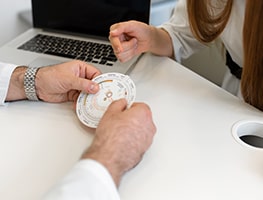It is said that 8–14% of couples struggle with infertility, i.e. they have been trying for over a year with no resulting pregnancy. Approximately 1 000 couples per year seek treatment at infertility clinics, the biggest of which is the Grootte Schuur Hospital Infertility Clinic.
General practitioners are usually reluctant to suggest a battery of fertility tests unless a couple has been attempting pregnancy for twelve months (or six months if either partner is over 35). Often you’ll be advised to chart your cycle or your doctor may suggest you purchase a basic fertility test kit that indicates ovulation is occurring.
If six to twelve months has passed and you’ve kept good records – such as a fertility chart or a fertility calendar showing likely ovulation dates in recent months – your doctor will have plenty of information to decide which fertility test is the next most appropriate test.
Going down the path of fertility testing can become expensive and stressful. It’s wise not to start doing fertility tests until you have spent a number of months using fertility awareness methods and making sure that you have sex on your most fertile days.
Don’t forget that any healthy young couple having unprotected sex has only a 20% chance of getting pregnant in any one month; give your body a chance.
Before the Fertility Test: Medical history and physical examination
Before ordering fertility tests, your doctor will take the sexual medical history of both partners. You will need to describe your menstrual cycle, fitness regime, sexual practices, history of birth control, discuss any sexually transmitted diseases you have had in the past, your use of both legitimate and street drugs and caffeine, alcohol and tobacco.
The physical examination of the female partner usually involves a pelvic examination and a pap smear. The physical examination of the male partner usually involves a thorough testicular examination.
Tests for sexually transmitted diseases may also be done at this time, which may involve collection of blood and urine samples, cervical samples and urethra samples.
Fertility Test: Semen Analysis (also called sperm count)
Until now, the embarrassing awkward stuff has all been women’s business, but this fertility test shares the pain a bit. The semen analysis is one of the earliest examinations and is usually the first test carried out on the male partner.
A specimen of semen for a fertility test is usually collected by the male partner masturbating into a laboratory container after several days’ abstinence from ejaculation. Because the specimen needs to be kept in a temperature-controlled environment and must be tested within about three hours, the collection is usually done either on the premises of the laboratory or at a location close to the laboratory.
The semen analysis fertility test involves examining the total volume of the sample, and for the amount of sperm present (this is also known as a sperm count), the concentration of the sperm (called, rather obviously, sperm concentration), whether the sperm are mostly uniform in shape and form (called morphology), how quickly the sperm are moving (called motility) and the pH of the semen.
Results are usually available the next day. Because semen samples can vary greatly from day to day, and can be affected by environmental factors, two or three samples are often requested over a three-month period to try to get consistent results.
It’s normal to be quite shocked and upset if fertility test results indicate a low sperm count, motility or other problems, however it’s important to discuss your results with your doctor as soon as possible. Many men are able to father children despite a low sperm count and various other sperm quality issues; and sometimes semen analysis can reveal a problem that may be able to be treated.
Fertility test: Hormone levels
Blood tests of both male and female partners may be arranged to check that there are normal and balanced levels of key fertility-related hormones such as follicle stimulating hormone (FSH), luteinising hormone (LH), oestrogen, progesterone, prolactin, testosterone and thyroid stimulating hormone (TSH).
Your doctor may arrange a series of blood tests (often taken every second day over a period of ten days) to check that hormone levels in the female partner are changing appropriately in the lead-up to ovulation. These tests will also indicate the most likely time of ovulation.
Hormone levels can’t confirm that the egg is actually released from the ovary nor can they confirm whether the egg is normal when released.
Fertility Test: Pelvic ultrasounds
A pelvic ultrasound may be ordered for one or both partners. You will probably need to attend a radiology clinic for this fertility test.
The pelvic ultrasound in the female partner may be both trans-abdominal (a handheld device is passed over the abdomen) and trans-vaginal (a very small handheld device shaped to fit the vagina is used to record images within the pelvis).
In the female partner, the pelvic ultrasound fertility test may check for pelvic inflammatory disease or for uterine fibroids. It will also examine the size and shape of the womb and the ovaries and check the lining of the womb (endometrium).
This fertility test will often also check for endometriosis, a common cause of fertility problems in women.
The pelvic ultrasound in the male partner may be both trans-abdominal and trans-rectal (using a small transducer shaped to fit into the rectum.) This fertility test will usually check the condition of the prostate gland and seminal vesicles.
Fertility Test: Hysterosalpingogram (HSG)
This fertility test for the female partner is an X-ray of the inside of the womb and the fallopian tubes which checks for any blockage in the fallopian tubes or any problems in the uterine lining that may prevent the implantation of a fertilised egg.
It is a quick test, taking around five minutes, and is usually done in a radiology clinic. Usually, before the X-ray, a cannula is inserted into the womb via the vagina and through the cervix, and then a dye solution (often using iodine) is injected into the uterine cavity.
Usually the dye will fill the uterine cavity and spill into both the fallopian tubes, then out at the ends to collect in the peritoneal cavity. You will be asked to roll from one side to the other and then hold still, so that an image of each tube can be recorded.
You’ll need to wear a sanitary pad after this fertility test as there is frequently some spotting for one or two days after the procedure. It is also not unusual to experience mild cramping after the procedure.
Fertility Test: Hysterosonogram (HSN) or Sonohysterogram
This fertility test is given a few different names: sonohysterogram, hysterosonogram, saline ultrasound, saline sonogram, or saline infusion sonogram. It has largely replaced the surgical fertility test procedure of hysteroscopy. It takes only a few minutes and uses a trans-vaginal ultrasound to look at the inside of the womb after filling it with saline fluid via a small plastic tube inserted through the vagina.
This fertility test is usually done in the time between the end of the menstrual period and ovulation, before the uterine lining normally starts to swell with blood vessels.
It is wise to wear a sanitary pad after the fertility test as there is sometimes some leaking of residual saline and although the procedure is a bit uncomfortable it is not usually painful; occasionally some women experience mild cramping.
Fertility Test: Endometrial biopsy
This fertility test procedure involves checking the tissues of the lining of the womb to check that hormones are stimulating the lining effectively enough for a fertilised egg to implant.
This fertility test is often done in conjunction with pelvic ultrasound. A speculum is inserted into the vagina and while the cervix is held open with a cervical dilator, a small plastic tube is passed through the cervix into the womb and a sample of uterine tissue is removed by suction.
It is common to have some spotting (light bleeding) for a day or two after this fertility test.
Fertility Test: Laparoscopy
This is a surgical fertility test and is thus usually done after as much information as possible has been gathered from other less invasive fertility tests. Make sure you ask your doctor to explain the potential risks of this procedure beforehand and take some time to think about them before you agree.
Laparoscopy usually involves day surgery and is done in hospital either under local or general anaesthetic, depending on the nature of the procedure. A small incision is made in the abdominal wall and carbon dioxide is blown in to distend the abdomen. Then a laparoscope (which is a thin instrument like a telescope) is passed in via the incision to examine the ovaries, fallopian tubes and womb.
The incision site can be sore for a few days after the procedure. As with most abdominal surgery, common after-effects include abdominal bloating, nausea, cramps and constipation for a day or two and there may be a couple of days of light spotting or bleeding.
For more information see fertility monitor or conception.
























